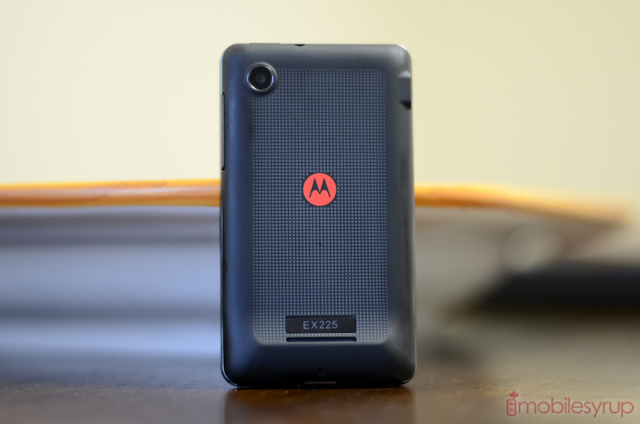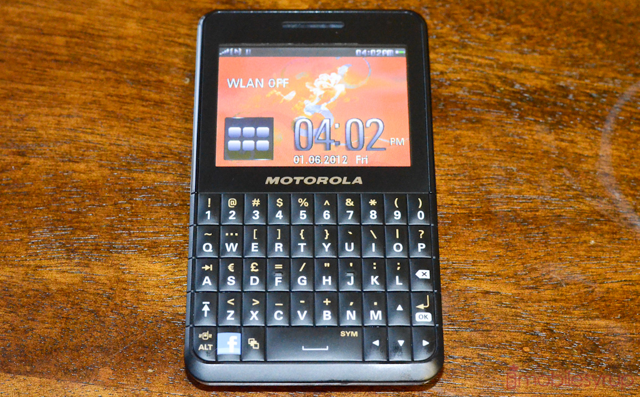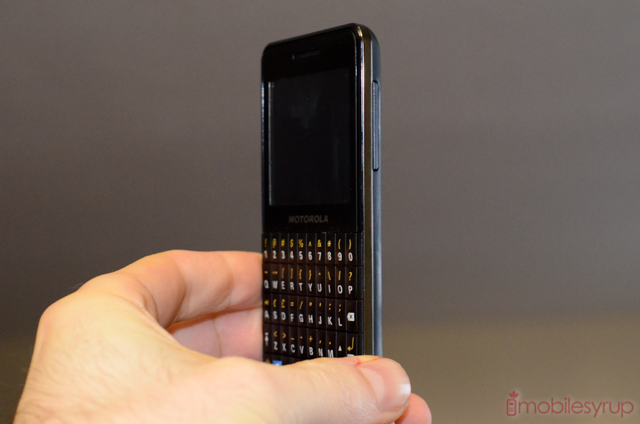The prepaid market is one that we don’t really broach too often, but it’s an essential component of everyday life for millions of Canadians. While the penetration rate for smartphones is nearly 40%, it’s still much more common to see someone with a cheap flip phone or aging candybar walking down the street. Smartphones are essential to peoples’ lives, but so is the savings from a $89.99 prepaid phone paired with a $20/month commitment-free rate plan.
The MOTOKEY SOCIAL, hereby deemed Motokey for austerity sake, is an interesting take on the the portrait QWERTY phone. At first glance it appears quite similar to the previously-reviewed Android-powered Motorola Pro+ but for the smaller screen and dedicated Facebook button.
Let’s take a look at this pseudo-smartphone and see if it’s right for you, or your younger sibling.

Specs:
– Custom Motorola operating system
– 2.4″ 320×240 capacitive touch screen
– 64MB RAM, 128MB ROM (50MB user available) with microSD slot
– 3MP camera
– GSM 850/900/1800/1900, EDGE Class 10, WCDMA 850/1900
– 910mAh battery
– WiFi / Bluetooth, GPS
– WiFi hotspot support
– Built-in Facebook button
– Stereo FM radio
– 87g
– 60 x 105.5 x 9.98 mm
—
It’s important to note that the Motokey is not, depending on your definition, a smartphone. It runs a touchscreen-“friendly” operating system, but it’s a far cry from the versatility of Android, or even Samsung’s Bada.
This simple Java-based operating system is surprisingly robust, with capacitive touchscreen support and native social networking features. There are smartphone features we take for granted, such as a Java browser (Opera Mobile), Twitter, Facebook, Gmail, Yahoo and weather applets. I’d be remiss to call them apps, but they perform ably enough.
There are five home screens, each of which is adorned with various widgets and app icons; holding down on one will bring up an ugly prompt asking to change the source of that shortcut. You cannot move an icon, or replace it with a widget, so an icon must be replaced with another, and a widget with another, and so on. The system works quite well, though getting things exactly right is time-consuming and cumbersome. Nevertheless, we have to go back to one thing: this phone provides, for $90, similar albeit vastly simplified functionality as a device three or four times the price.
The hardware is quite hardy for such an inexpensive device. The keyboard is similar to the one on the Motorola Pro+, but adds a dedicated number row in the space where an extra half-inch of screen space would be. The keys are spritely and well-honed, spaced just right for messaging hounds; the number row will appease those with aversions to the “BlackBerry Way” of holding down the alt key for most secondary presses. As you can see, like the Android-powered HTC Status there is a dedicated Facebook button near the bottom left of the keyboard. Such an inclusion leaves no doubt as to whom this diminutive device is to be marketed to.
The 2.4″ QVGA screen is appreciably crummy, but not a write-off. With sufficient brightness, clarity and touch responsiveness, it’s a great deal better than a resistive layer. Viewing angles are pretty laughable though, and you can see the banding in most gradients, owing to the limited colour palette.
Around the back is a 3MP camera, for which the software could be worse: one-touch Facebook sharing, plus decent response time makes for a pleasant enough experience. I foresee many young people pointing the lens at their own faces, friends gathering in the shot for a candid self-portrait. The lack of flash is no surprise, but one can take grainy and low-framerate video at a decent 640×480 resolution.
Though the phone does not come with a microSD slot, the phone supports one up to 32GB, and it’s a good thing too, since there are only 50MB of usable storage out of the box for photos, video and music. There is a decent media player built in, though, to accompany the top-side 3.5mm headphone jack. Indeed, the phone appears to be a smartphone from the look of it: it is charged with an industry-standard microUSB cable (provided, thankfully) and has similarly robust build quality.
The Motokey is ringed by a chrome plastic bezel, to which a sturdy battery cover is attached. Underneath the hood is a 910mAh battery, but I had no issues with the battery. Since I couldn’t perform my usual suite of battery tests (for lack of apps), I merely repeated a short video I filmed until the cell wore to zero. The phone lasted nearly fifteen hours on medium brightness, indicating a relatively mild battery draw under load.
Surprisingly, the Motokey has a built-in WiFi hotspot feature to accompany the HSPA+ baseband inside. Telus offers a wide range of Prepaid Plans, though the base cost is 20c/min with a monthly plan and 30c/min without one. Data can be added, in 250MB/month increments, for $20, though it does not look like it can be combined with a voice plan. One plan, which includes such “deals” as $45/month Unlimited Voice gives you access to 5 numbers, plus evenings after 6pm and weekends and no-limit messaging, are a far cry from post-paid contract rates, but perform the function for those people who want nothing to do with a 3-year contract. Per-use data rates are $3/MB.
 Thankfully, like all Motorola phones, call quality is excellent. There is an ample-sized speaker on the back for those tinny music urges, and the device, which is around the same height and width as the BlackBerry Curve 9360, is very comfortable to hold in the hand.
Thankfully, like all Motorola phones, call quality is excellent. There is an ample-sized speaker on the back for those tinny music urges, and the device, which is around the same height and width as the BlackBerry Curve 9360, is very comfortable to hold in the hand.
There is no doubt that the MOTOKEY SOCIAL is not aimed at me, nor most of our readers. But I decided to review it precisely because it is the type of phone that parents will buy their kids, or themselves, if cost is important and usage is kept to a minimum. Prepaid costs can add up quickly, but those who will seek one out are unlikely to be the heavy “Crackberry” users who will invest in an expensive handset.
As such, the Motokey gets a hearty recommendation without many of the reservations I usually foist on a smartphone. For $89.99 outright, and a $20/month prepaid plan which comes with no commitment, it’s the most robust and feature-filled fuss-free handset I’ve used.
The MOTOKEY SOCIAL is available from Telus for $89.99 outright.






